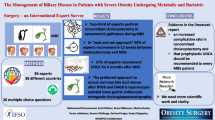Abstract
Indications for surgery of duodenal ulcer (DU) have changed radically because of the efficacy of H2-antagonists, endoscopic procedures, and eradication of Helicobacter pylorus. The aim of this study was to analyze the current literature to determine if definitive surgery is still relevant for complicated DU (bleeding, perforation, gastric outlet obstruction). Two studies have compared early to late surgery in terms of bleeding. One recommended early surgery (significant reduction in mortality) in the elderly, but no statistically significant difference was found when analyzed with “intention to treat.” In the other, mortality with early surgery was five times higher than with expectant therapy (when it was possible). Two studies comparing different surgical techniques for bleeding favored the radical procedure. Of at least 15 studies comparing endoscopic treatments, however, none has compared endoscopic therapy to surgical intervention for bleeding DU. One trial, comparing nonoperative to surgical treatment for perforation, found similar rates of morbidity, intraabdominal abscess, and mortality; but the hospital stay was longer (p < 0.001). Nonoperative treatment failed more often (p < 0.05) in patients over age 70. In three trials, postoperative morbidity (excepting wound sepsis in one) was not significantly increased by definitive surgery, with less ulcer recurrence (p < 0.05) compared with simple closure. Laparoscopy (versus laparotomy) was shown to take longer (p < 0.001) but required less postoperative analgesics (p < 0.03); there were no statistically significant differences as concerns the duration of nasogastric aspiration, intravenous drips, hospital stay, time to resume normal diet, Visual Analogous Scale pain scores for the first 24 hours after surgery, morbidity, reoperation rate, or mortality. Of 48 laparoscopic patients, 11 (23%) underwent conversion to open surgery. Three surgical techniques [highly selective vagotomy (HSU) + gastrojejunostomy (group 1), HSV + Jaboulay gastroduodenostomy (group 2), or selective vagotomy (group 3) + antrectomy) for gastric outlet obstruction (GOO)] showed that although postoperative results were similar (except wound sepsis in one trial), long-term Visick scores were significantly (p < 0.01) better in group 1 than in group 2, but not in group 3. Further studies are needed to determine the exact prevalence of Helicobacter pylori in complicated DU and to compare (1) definitive to minimal surgery (stop the bleeding or close the perforation) combined with antisecretory drugs and eradication of H. pylori; (2) surgery to endoscopic treatment combined with eradication of H. pylori; and (3) for GOO, surgery to balloon dilatation combined with eradication of H. pylori.
Similar content being viewed by others
Author information
Authors and Affiliations
Rights and permissions
About this article
Cite this article
Millat, B., Fingerhut, A. & Borie, F. Surgical Treatment of Complicated Duodenal Ulcers: Controlled Trials. World J. Surg. 24, 299–306 (2000). https://doi.org/10.1007/s002689910048
Published:
Issue Date:
DOI: https://doi.org/10.1007/s002689910048




